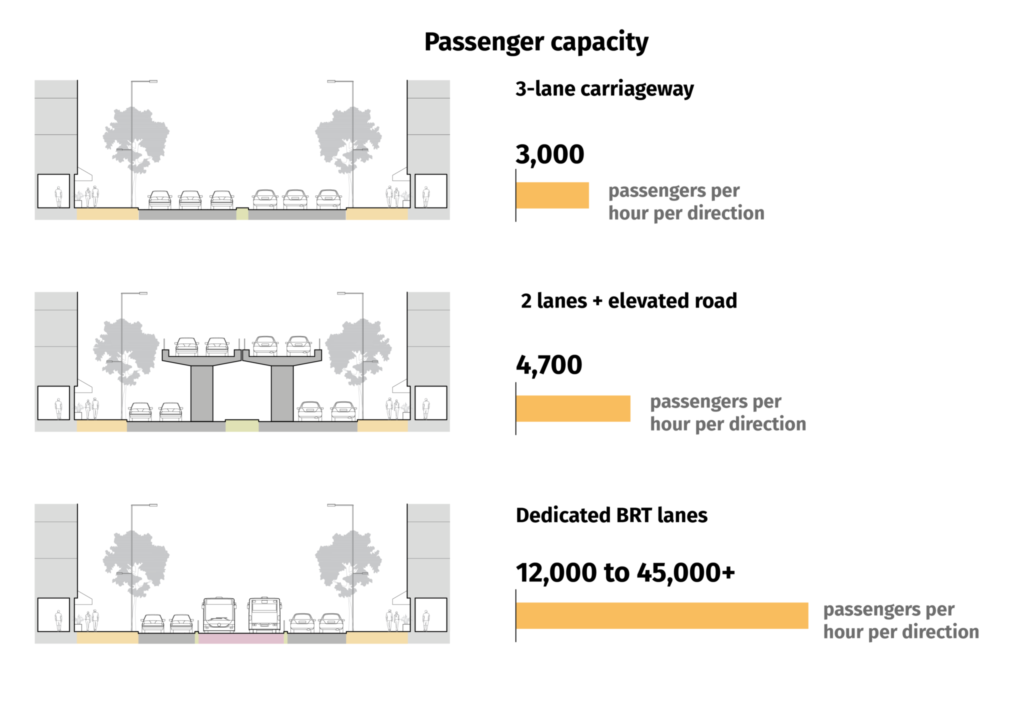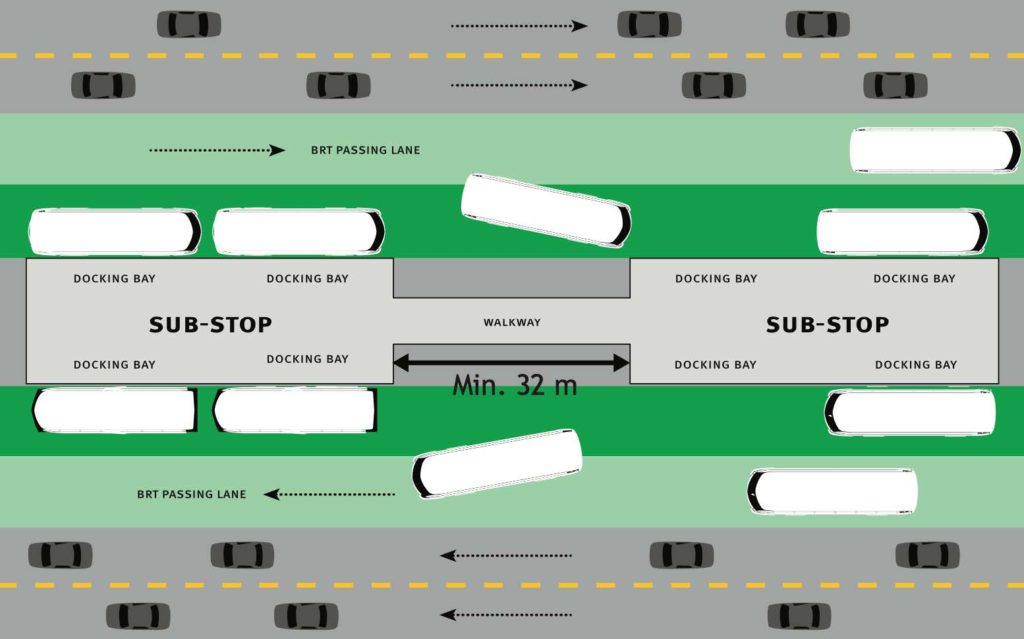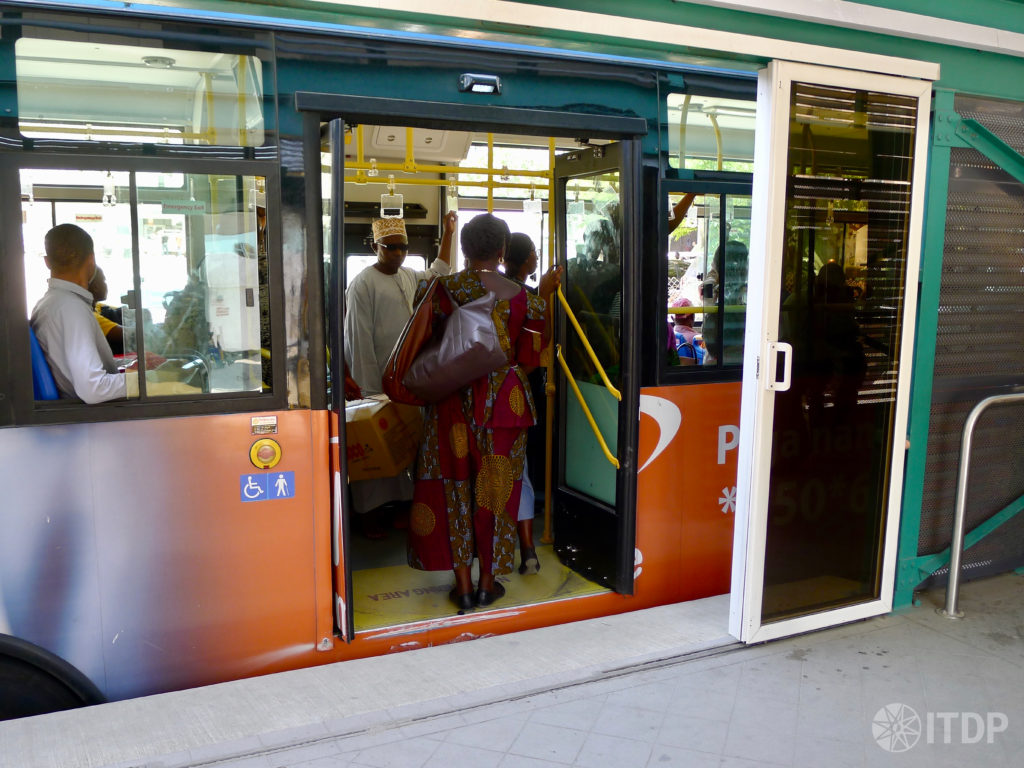
March 15, 2022
Enhancing the viability of bus rapid transit in Nairobi
Cities across Africa have been planning and developing bus rapid transit (BRT) systems to improve the efficiency of public transport and give commuters an alternative to sitting in the jam. BRT is attractive because it allows for a large increase in public transport capacity at relatively moderate costs compared to commuter rail or metro systems
BRT enables cities to carry a large number of passengers without an exponential increase in road space requirements. A single BRT lane with articulated buses can carry 13,000 passengers per hour per direction (pphpd), and if passing lanes are added at stations, the capacity increases to 38,000 pphpd. The same lane can carry 800 cars per hour—only 1,200 to 1,600 persons at typical occupancy rates—assuming that the lane receives one half of the signal time at intersections.

Well-designed BRT infrastructure can ensure fast and efficient operations by preventing delays. Operational efficiency in turn determines the competitiveness of a BRT system and ultimately the willingness of users to switch from private vehicles, leading to improved access for all.
Successful BRT systems need well-planned infrastructure in line with existing and future demand patterns. Information on passenger movements is key in determining the corridor infrastructure, BRT routes, BRT fleet, bus frequencies, station locations, and station sizing. Infrastructure design should support the value proposition of efficient, reliable, affordable, and shorter commutes, prompting residents to switch from private vehicle and paratransit use.
Dedicated median aligned BRT lanes with physical barriers ensure that BRT lanes are not used by regular traffic. The dedicated lanes allow for quick, timely, and efficient movements. Median lanes ensure there is no conflict or delay caused by vehicles turning onto side streets or into adjacent properties. In Accra, Ghana, when the government lacked the capital to invest in continuous dedicated bus lanes, mixed traffic movements led to fierce competition between the newly launched Aayalolo bus service and other paratransit operators, who would use the bus stops and bus lanes marked for Aayalolo in the absence of security personnel. Competition for passengers at bus stops delayed commutes and as a result, the system lacked scheduled efficient service and had no advantage over private vehicles or regular paratransit.
For corridors with high demand, such as Nairobi’s pilot BRT line 2 which runs along the Thika highway and then enters the central business district (CBD), planning should prevent delays and bottlenecks at stations and intersections. To reduce station congestion, high demand stations need passing lanes. The Nairobi line 2 service plan estimates that the system will carry 550,000 passengers per day. Passing lanes allow for express services, which offer faster commercial speeds than all-stop services and reduce station congestion further. On Thika Rd, many buses and matatus already offer semi-express service, so the BRT needs passing lanes to be competitive with these routes.
Station sizing depends on the bus frequency and the level of passenger demand. Stations with high demand require multiple independent docking bays (sub-stops) to ensure efficiency and speed while increasing capacity. Stations must be long enough to allow the sub-stops to function independently of one another. The distance between the independent sub-stops should be at least 1.8 times the bus length (32 m for an articulated bus) to enable buses to manoeuvre easily. Space should be reserved in the median for the addition of new sub-stops based on the future growth in passenger demand.
A well-designed BRT system enables the majority of commuters to reach their final destinations with few or no transfers. One way to do this is by offering direct services that extend beyond BRT corridors. For Thika road, a dedicated corridor is needed along the 16 km in the core city, where congestion is most severe. Direct services would pick up passengers from residential areas such as Zimmerman, Mwiki, Ruiru, Juja, and Thika, and then enter the dedicated corridor. In the city centre, direct services would extend to Westlands and Upper Hill, thereby allowing passengers to reach their destinations without making a transfer in the CBD.

A BRT station should contain ramps, a fare collection area, and a boarding area. Ramps should be constructed in tactile paver blocks and with a slope not exceeding 1:12, making it convenient for people with disabilities. The fare collection area should contain system information displays and a place for customers to recharge smart cards and make enquiries. Passengers tap their smart cards or smartphones at turnstiles and proceed to the boarding area. The boarding area should provide space for people waiting for buses as well as circulation space for people entering or leaving the station. For small to medium stations, bus docking positions in either direction can be staggered, reducing the required width of the station and for easy circulation of people inside the station. The station platform height should be the same as the bus floor height. Level boarding allows for ease of movement and reduces the amount of time that the bus needs to remain stopped at the station.

In the Nairobi central business district, where BRT buses will pass through several intersections, signal cycles that prioritise BRT movements can be implemented to minimise delays and disruptions. Right turns across BRT lanes should be avoided to reduce intersection delays. Instead, vehicles can make a series of turns and then cross perpendicular to the corridor. In this way, signal cycles can be limited to two phases.
Non-motorised transport access is crucial in order to provide seamless pedestrian connectivity. Footpaths should have at least 2 m of clear space for walking, with wider walkways provided in activity centres such as Githurai. To enhance last-mile connectivity, BRT corridors should also include cycle parking areas at all stations and dedicated cycle tracks constructed with asphalt or concrete and physically separated from mixed traffic.
Well-designed BRT infrastructure can ensure fast and efficient operations by preventing delays. Operational efficiency in turn determines the competitiveness of a BRT system and ultimately the willingness of users to switch from private vehicles, leading to improved access for all.
